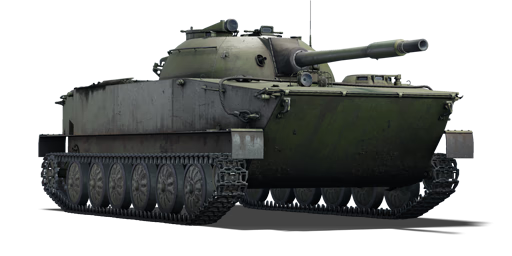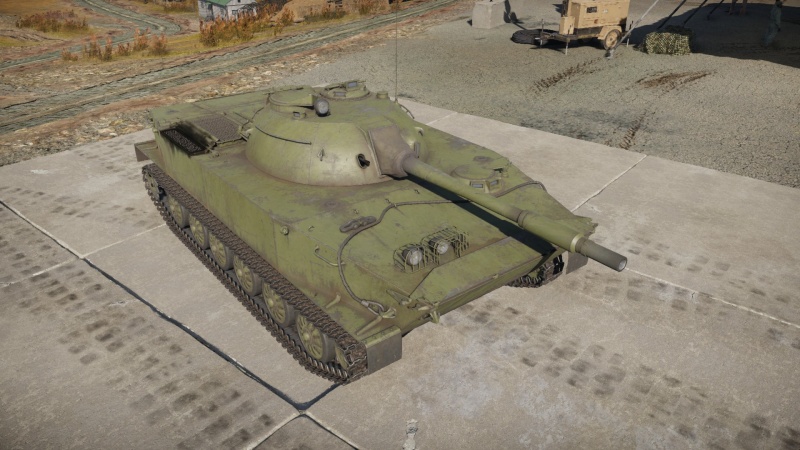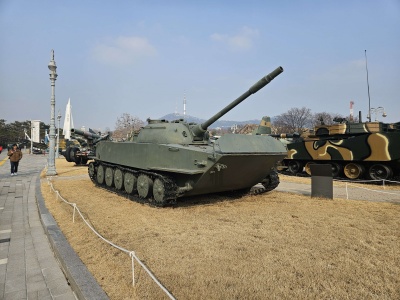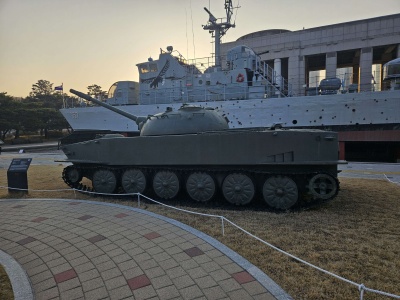Type 63
| This page is about the Chinese light tank Type 63. For other uses, see Type 63 (Disambiguation). |
Contents
Description
The Type 63 amphibious tank (63式水陆坦克), the first variant of the Type 63 amphibious tank family, was China's first generation of amphibious tanks, based on the Soviet PT-76 and developed and built by China North Industries Corporation. In 1950, China purchased some PT-76 amphibious tanks from the Soviet Union. Using the PT-76 as a guide, China began the development of its own amphibious tank. In 1959, factories code-named 201 and 617 developed initial prototypes that replicated the PT-76, and a small number of prototypes were delivered to the Chinese People's Liberation Army for trial in 1960. Improvements were made in response to problems discovered during trial production and testing, and the design was finalized in March 1963. It was given the designation Type 63 amphibious tank and went into full production. The Type 63 amphibious tank first saw service in 1964 and was sent to North Vietnam for deployment throughout the Vietnam War. It also saw limited action in the 1979 Sino-Vietnamese War.
Introduced in Update 1.91 "Night Vision", the Type 63 is the first domestic Chinese amphibious tank based on the Soviet-produced PT-76 amphibious light tank. The Type 63, which uses the same turret as the Type 62, possesses significantly greater firepower than its Soviet counterpart. Despite its lack of armour, the Type 63 amphibious tank is equipped with HEAT-FS, which can penetrate 300 mm of armour. However, it lacks the two-plane stabilizer featured in later PT-76 variants, making accurate fire while moving difficult.
General info
Survivability and armour
Armour type:
- Rolled homogeneous armour
- Cast homogeneous armour (Turret front/sides, Gun mantlet)
| Armour | Front | Sides | Rear | Roof |
|---|---|---|---|---|
| Hull | 11 mm (82°) Upper glacis 14 mm (42°) Lower glacis |
13 mm Top 10 mm Bottom |
10 mm (1°) Top 10 mm (62°) Bottom |
10 mm |
| Turret | 11 mm (15-58°) Turret front 15 mm (10-69°) Gun mantlet |
11 mm (17-58°) | 11 mm (10-48°) | 10 mm |
| Cupola | 10 mm | 10 mm | 10 mm | 10 mm |
Notes:
- Suspension wheels are 10 mm thick.
- Tracks are 15 mm thick.
The Type 63's armour is no better than the PT-76 and should not be relied upon against any incoming fire. Even heavy machine guns and autocannons pose a serious threat to this vehicle; the turret has only 11 mm of cast steel for example and can be easily penetrated by the M2 Browning commonly mounted on US tanks. SPAAs and aircraft will rip the tank to shreds. In general, avoid being spotted and stay close to cover. Placing bushes on the front and top of the tank to delay recognition by enemies, even for a second or two, can help considerably.
The Type 63 is vulnerable to overpressure damage. Chemical shells (HEAT, HEAT-FS, HE) of at least decent size will trigger it consistently. Kinetic shells tend to be less threatening; generally speaking, APHE rounds will only fuse if fired through the lower glacis, which has exactly enough armour to trigger the common 14 mm fuse sensitivity. The thinly armoured turret will not fuse most APHE rounds and it is possible for a Tiger II (P)'s fearsome PzGr 39/42 to pass through a turret cheek and only take one to two crew members with it.
The crew of 4 is better than the 3 in the PT-76, but the additional crew member resides in the crowded turret and the benefits to survivability are marginal.
Mobility
| Game Mode | Max Speed (km/h) | Weight (tons) | Engine power (horsepower) | Power-to-weight ratio (hp/ton) | |||
|---|---|---|---|---|---|---|---|
| Forward | Reverse | Stock | Upgraded | Stock | Upgraded | ||
| Arcade | 72 | 9 | 18.4 | 620 | 763 | 33.7 | 41.47 |
| Realistic | 65 | 9 | 354 | 400 | 19.24 | 21.74 | |
The Type 63 sees a decent improvement in mobility compared to the previously preceding PT-76, however, it's essentially identical to the Object 211. This makes this tank very attractive for flanking or early-game rushing. The Type 63 is also good for hill-climbing and can reach some nifty positions on some maps. The mobility lags slightly behind some contemporary tanks like the M41 Walker Bulldog and wheeled Italian vehicles are much faster on roads. It will still handily outrun medium and heavy tanks. The reverse speed of about 8 km/h is a slight improvement over the T-34-85 (S-53) but by no means lightning-quick. If using shoot-and-scoot tactics, start backing into cover as soon as possible after firing a shot.
As an amphibious vehicle, the Type 63 will not drown in water and can swim across rivers or lakes at 11.7 km/h. However, the lack of a gun stabilizer makes firing while on water very difficult. Avoid driving on water for more than short crossings if enemies are likely to see you, as it will be nearly impossible to defend yourself.
Modifications and economy
The Type 63's stock grind is less painful than the PT-76 since it has a decent gun with usable ammunition from the start. But the tank does not have much going for it over a T-34-85 until the Type 56 HEAT-FS, a Tier IV modification, is researched. Try focusing on the firepower modifications after Parts are unlocked, as the vehicle's stock mobility is not bad. Adjustment of Fire is very important since the Type 63's long reload does not give it much leeway if one's shot misses. Once the HEAT-FS is unlocked, the grind becomes significantly easier since the tank is now capable of harming enemies frontally from any distance, making assists much easier to come by and reducing its reliance on flanking.
Armaments
Main armament
The Type 63 cannon is also used by the Type 62 and early Obj. 211. This means that it has the same sluggish reload as the PT-76 despite having a dedicated loader. The gun handling is poor all-round, with the gun rotation, elevation, and depression speeds all being lower than the PT-76. This can be a pain when using the Type 63 aggressively; unfortunately, the gun handling cannot keep up with the good mobility.
| 85 mm Type 63 | Turret rotation speed (°/s) | Reloading rate (seconds) | |||||||||||
|---|---|---|---|---|---|---|---|---|---|---|---|---|---|
| Mode | Capacity | Vertical | Horizontal | Stabilizer | Stock | Upgraded | Full | Expert | Aced | Stock | Full | Expert | Aced |
| Arcade | 47 | -4°/+22° | ±180° | N/A | 9.5 | 13.2 | 16.0 | 17.7 | 18.8 | 9.10 | 8.05 | 7.42 | 7.00 |
| Realistic | 5.9 | 7.0 | 8.5 | 9.4 | 10.0 | ||||||||
Ammunition
Two APHE shells are available. The stock Type 56 APBC round has rather low penetration for its rank, but this is compensated by its excellent slope modifiers and high explosive mass. It penetrates other light tanks easily and is the best round to use when flanking. The Type 56 APCBC round has about 30 mm of extra penetration with less than half the TNT equivalent; while this is not a bad tradeoff, in practice it does not frontally penetrate many vehicles that the Type 56 APBC round cannot, and when flanking the lower post-penetration damage is a big drawback. Using one or the other is mostly up to personal taste, though it does not hurt to bring some of both.
The Type 56 HVAP shell has high velocity and better flat penetration than the APHE rounds, but as with other shells of its class, the angled performance and post-penetration damage are awful. It is best used as an interim shell before the HEAT-FS is unlocked; in emergencies it can penetrate the turret face of the Tiger II (H) at close range.
The Type 56 HEAT-FS shell is the most powerful option available to the Type 63 and is very strong for its rank. 300 mm of flat penetration at any distance with good velocity and angled performance is no joke, capable of nullifying the armour of many heavy tanks. The main rival at the battle rating of 6.3 is the ST-A1's 90 mm HEAT-FS with 305 mm of flat penetration. It boasts more TNT equivalent than the HE shell, making it dangerous to lightly armoured targets like the common M18 Hellcat that are vulnerable to overpressure. The main drawbacks are the mediocre post-penetration damage and the tendency to bounce against heavily sloped armour, so aim carefully for important crew members, modules, and ammo racks.
The Type 56 HE shell is very weak and should be avoided because the HEAT-FS is better in all aspects.
| Penetration statistics | |||||||
|---|---|---|---|---|---|---|---|
| Ammunition | Type of warhead |
Penetration @ 0° Angle of Attack (mm) | |||||
| 10 m | 100 m | 500 m | 1,000 m | 1,500 m | 2,000 m | ||
| Type 56 APBC | APHEBC | 135 | 133 | 124 | 113 | 104 | 95 |
| Type 56 APCBC | APCBC | 164 | 162 | 154 | 143 | 134 | 125 |
| Type 56 HVAP | APCR | 208 | 201 | 176 | 148 | 125 | 106 |
| Type 56 HEAT-FS | HEATFS | 300 | 300 | 300 | 300 | 300 | 300 |
| Type 56 HE | HE | 19 | 18 | 17 | 16 | 15 | 14 |
| Shell details | ||||||||||||
|---|---|---|---|---|---|---|---|---|---|---|---|---|
| Ammunition | Type of warhead |
Velocity (m/s) |
Projectile mass (kg) |
Fuse delay (m) |
Fuse sensitivity (mm) |
Explosive mass (TNT equivalent) (g) |
Ricochet | |||||
| 0% | 50% | 100% | ||||||||||
| Type 56 APBC | APHEBC | 792 | 9.2 | 1.2 | 14 | 164 | 48° | 63° | 71° | |||
| Type 56 APCBC | APCBC | 792 | 9.2 | 1.2 | 14 | 77 | 48° | 63° | 71° | |||
| Type 56 HVAP | APCR | 1,020 | 5.3 | - | - | - | 66° | 70° | 72° | |||
| Type 56 HEAT-FS | HEATFS | 845 | 7 | 0.05 | 0.1 | 822.8 | 65° | 72° | 77° | |||
| Type 56 HE | HE | 785 | 9.54 | 0.2 | 0.1 | 741 | 79° | 80° | 81° | |||
Ammo racks
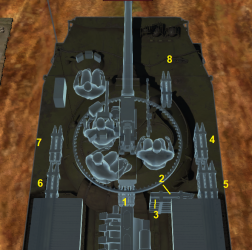
| Full ammo |
1st rack empty |
2nd rack empty |
3rd rack empty |
4th rack empty |
5th rack empty |
6th rack empty |
7th rack empty |
8th rack empty |
Visual discrepancy |
|---|---|---|---|---|---|---|---|---|---|
| 47 | 42 (+5) | 36 (+11) | 30 (+17) | 24 (+23) | 15 (+32) | 11 (+36) | 7 (+40) | 1 (+46) | Yes |
Note:
- Ammo rack #1 is in the back of the turret basket and will rotate with the turret.
The poor protection of the Type 63 means that taking less ammunition will not improve post-penetration survivability by much. Taking 30 rounds or less will empty the ammo racks in the back of the fighting compartment and turret basket, so solid projectiles entering the front right of the vehicle might pass through and hit only the loader. This is mildly helpful against British tanks and M41s. If 30 rounds is not enough, a rare occurrence, it's fine to take more.
Machine guns
The Type 63 has a coaxial 7.62 Type 59 machine gun. It is useful for spotting targets on the map but little else. The Type 59 machine gun is the Chinese variant of the Soviet SGMT, which enjoy a much larger magazine and better rate of fire than the typical WWII-era DT machine gun, which helps to clear fences and bushes that might prematurely detonate the HEAT-FS round. The lack of a pintle-mounted heavy machine gun makes it difficult to ward off aircraft or gun down light vehicles like armoured cars.
| 7.62 mm Type 59 | ||||
|---|---|---|---|---|
| Mount | Capacity (Belt) | Fire rate | Vertical | Horizontal |
| Coaxial | 2,000 (250) | 600 | - | - |
Usage in battles
The Type 63 is best used in a way that avoids direct exposure to enemy fire and gives you time to set up shots and ambushes. Running straight into battle or rushing cap points may not end well. Flanking is a recommended method as this gives you the time you desperately need due to slow turret rotation and reloading. It also gives you chances to shoot at enemy side armour, which is the only way to penetrate heavier enemies if you use conventional shells. When flanking, avoid driving in the open if possible and keep an eye out for other light vehicles. Some of them, like armoured cars and Hellcats, can be overpressured by the HEAT-FS round on occasion, while others like the M41 Walker Bulldog used by several nations cannot and are best dispatched with the APHE rounds. Once a good position is reached, stay close to cover and be sure to hide when reloading.
The long reload makes selecting the right ammunition type for the situation very important. Otherwise, switching to the correct round could take up to 11 seconds, enough for an enemy to retreat or return fire. It is better to keep HEAT-FS loaded when entering an engagement if enemy types are unknown; any target that the HEAT-FS cannot overpressure can still be disabled with a careful shot to the gunner/driver/gun breech, and APHE can be used to finish crippled targets off. On the other hand, the first speedy enemies to appear at the start of a match are probably soft enough to destroy with APHE. Try to reload while in cover.
Like many domestic PRC tanks, the Type 63's gun handling is quite awful, so predict where enemies are likely to appear and always be on the lookout for potential ambushes or flankers. If your aim must be shifted rapidly, turn the hull as well as the turret. Though it lacks neutral steering, the hull traverse is quite good. Avoid trying to take down or harass aircraft unless they are bold enough to fly directly at you and escaping to cover is impossible.
Ground targets to watch out for include the infamous R3 T20 FA-HS, whose extreme mobility and rapid-fire autocannon are the bane of the Type 63's bad gun handling and armour, and the Ru 251, which also has incredible speed and can overpressure the Type 63 with its chemical rounds.
Besides flanking, another tactic is to use the HEAT-FS shells for long-range sniping. The HEAT-FS does not lose accuracy nor penetration at range, giving you the full 300 mm penetration on each hit. Shooting and relocating are advisable because if an enemy manages to be within range of you, they will only need one shot to take you out. Stay hidden or retreat if an enemy is looking in your direction and ready to fire, as the Type 63 does not have the gun handling or armour necessary to peek effectively. Keep an eye on the sky and switch positions after a few kills, as it is very likely that planes and artillery will be on their way to seek revenge. Virtually any aircraft can dispatch the Type 63, even those lacking bombs or rockets.
Remember to constantly mark enemies with scouting. Besides helping your team and gaining assists for yourself, it allows teammates to mop up targets that you have crippled but are unwilling or unable to finish off. The reduction in aircraft spawn cost is also valuable due to the Type 63's fragility. If a good early-game run with the tank is terminated, it should be easy to pull out a suitable CAS aircraft like the Tu-2 or counter-CAS aircraft like the La-9 to exact revenge while leaving points in reserve for later spawns.
Pros and cons
Pros:
- Same 85 mm gun as the Type 62, more powerful and much less frustrating to use than the now hidden PT-76
- HEAT-FS penetrates up to 300 mm of armour, excellent for the battle rating and is a huge improvement over the Obj. 211
- Good gun optics with 3.5-7x zoom
- 4 crew members
- Improved mobility from the formerly preceding PT-76
- Can scout and assist with repairs
- Amphibious
Cons:
- No stabilizer, firing on the move or water is difficult
- Very thin armour, vulnerable to overpressure damage
- Poor gun handling
- Slow turret traverse
- Slow reload, especially for a light tank
- No sources of smoke
- Larger profile than the PT-76 family
History
The Soviet Union delivered PT-76 tanks to the People's Republic of China in the 1950s. Their lightweight and amphibious capability was appreciated by the PLA, and in 1958 an order was placed for the development of an indigenous vehicle in the same vein. Initially, a copy of the PT-76 called the Type 60 was made, but unsatisfactory performance and reliability issues prompted a redesign. The new design was finalized in 1963 and entered service as the Type 63 light tank, not to be confused with the Type 63 armoured personnel carrier that served as a basis for the ZSD63. While resembling the PT-76, the Type 63 tanks featured notable differences, such as a new engine, a relocated driver's station, and a new turret with an 85 mm gun. Overall dimensions were slightly enlarged for extra flotation. The Type 63 was intended for use in the wet and muddy terrain of southern China and also for seaborne assaults - many were stationed on the southern coast, across the strait from Taiwan.
Type 63 has a V12 12150-L2 engine developing about 400 hp. Additional upgrades were developed over the years. The later Type 63 variant from the 1970s added a laser rangefinder and night vision equipment. The 63HG variant from the 1990s had a boat-like hull with a rounded nose and a modified turret with a 105 mm gun. In the late 1990s, the ultimate Type 63A variant entered service. It featured a new welded turret with improved protection, a 105 mm gun, modern fire control systems, and a further redesigned hull.
The Type 63 was exported to several countries, including Myanmar, Albania, and Vietnam. It remains in use with several of them today. The Type 63A, which is a modification of the Type 63 with a 105 mm gun and improved armour, still serves with the PLA today, however, it is being gradually replaced by the larger and more advanced ZTD-05 amphibious assault vehicle.
Media
- Skins
- Images
See also
External links
Paste links to sources and external resources, such as:
- topic on the official game forum;
- other literature.
| Norinco (China North Industries Corporation) | |
|---|---|
| Light AFV/IFV | |
| WZ501 | ZBD86¹ |
| WZ131 | ▂Type 62 · Type 62 |
| WZ211 | Type 63 · ZTS63 |
| WZ502 | ZBD04A |
| MBT | |
| WZ120 | Type 59¹ · ZTZ59A · ZTZ59D1 |
| WZ121 | Type 69 |
| WZ122 | ZTZ88B · ZTZ88A · ZTZ96 · ZTZ96A · ZTZ96A (P) |
| WZ123 | ZTZ99-II · ZTZ99-III |
| WZ1001 | WZ1001(E) LCT · ZTZ99A |
| Tank Destroyers | AFT09 · PTL02 · PTZ89 · ZLT11 |
| SPH | PLZ83 |
| SPAA | ZSD63/PG87² · PGZ09 · PGZ04A |
| Export | |
| WZ121 | Type 69-IIa · T-69 II G |
| MBT2000 | MBT-2000 · Al-Khalid-I |
| MBT3000 | VT4A1 |
| Other | WMA301 · WZ305 |
| ¹ License production / Reverse engineered · ² Field modifications | |
| China light tanks | |
|---|---|
| Type 63 | Object 211 · Type 63 · ZTS63 |
| Type 62 | Type 62 |
| WZ551 | ZSL92 · PTL02 · WMA301 |
| ZBL08 | ZLT11 |
| Type 86 | ZBD86 |
| WZ502 | ZBD04A |
| ROC | M41D · M64 |
| Type 59 | QN506 |
| USA | ␗M8 LAC · ␗M3A3 Stuart · ␗M3A3 (1st PTG) · ␗M5A1 · ␗M24 · ␗M18 GMC · ␗M41A3 |
| USSR | ␗T-26 · T-26 No.531 · ␗PT-76 |


